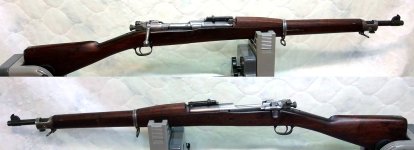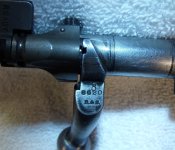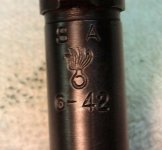HI, I"m new to the forum. I have just acquired a Remington Modified M1903, made in August, 1942. It has many mysteries I'm trying to solve. I just uploaded three photos, one is the gun as is. The second one is the bolt, and I am trying to identify the markings on it, for instance who is "B.&S" stamped on the bolt, and what does the number 8620 mean. I think there is a small flaming bomb there also?? The third photo is of the barrel markings. The question is this, given the gun was made by Remington in 1942, how did it get a Springfield barrel, also dated in 1942? I would think that if the gun was re-barreled, then the new barrel would be of a much later date??? Anyway, it's a great shooter and I love it! Thanks for any advice. larry.k
You are using an out of date browser. It may not display this or other websites correctly.
You should upgrade or use an alternative browser.
You should upgrade or use an alternative browser.
New Remington M1903 Owner!
- Thread starter LCK
- Start date
Jim Watson
New member
B&S indicates the bolt was made by Browne & Sharpe tool company.
The 8620 may indicate the steel alloy used.
I don't know why you have a Springfield barrel on a Remington rifle unless a replacement or a supplemental source. Springfield sure wasn't making any bolt actions in 1942.
The 8620 may indicate the steel alloy used.
I don't know why you have a Springfield barrel on a Remington rifle unless a replacement or a supplemental source. Springfield sure wasn't making any bolt actions in 1942.
Thanks Jim. Say, I was thinking maybe the gun was over hauled later at a army unit armory and they had some old stock barrels which they installed on rebuilds like this one. I think the barrel is an original from SA, and it does seem odd that the date is 06/42, since the SA was in production on the Garands by then. Guess I"ll have to check the Garand manufacturing schedules. thanks, larry.k
The question is this, given the gun was made by Remington in 1942, how did it get a Springfield barrel, also dated in 1942?
Because that is the way the military supply system works. The fact that both action and barrel are from different makers with the same date is just serendipity.
All the parts from all the makers go into the GI supply system, at after that point, no effort is made to track them by maker. All parts are (supposedly) inspected, and meet the GI specs, so they are all "generic" in that sense.
Barrel, M1903, one each, stock # XX-XXX-XXXX is all there is and all the military system cares about.
If the shop doing the work has a supply of barrels the action is going to get which ever one the repairman grabs out of the bin.
if they don't have a shop stock supply of the needed part, it gets ordered, and what ever the supply system delivers is what gets used. And, what the supply system delivers is what ever they have in their inventory. It may be a part that was made years before. The supply guy picks one out of their bin and sends it to the requesting unit. No one in the service cares if the part was made by Remington, Winchester, Springfield, GM, Singer, Whirlpool or any other contractor. Only civilian collectors care about such things.
I was an Army Small Arms Repairman (MOS 45B20) in the 70s. That is what we did. I have complete confidence that is how the system worked during WWII, and pretty sure its still how it works today.
At the end of WW2, the Army ran an inspection process.
All returned small arms were inspected, any worn, or defective parts were replaced.
As it has been pointed out, the armors didn't care what went where.
After inspection, the arms were either warehoused ,or released for reissue.
All returned small arms were inspected, any worn, or defective parts were replaced.
As it has been pointed out, the armors didn't care what went where.
After inspection, the arms were either warehoused ,or released for reissue.
This may be a bit off the wall but when Remington started making the 1903 Springfield early on, would it be a possibility that Springfield Armory might have supplied some of the barrels early on while Remington was getting geared up for full production. Just a thought that came to me while reading on this.
Paul B.
Paul B.
Jim Watson
New member
Possible, but Remington started making 1903s in October 1941, I would think they were tooled up for barrels by the next August. Maybe a supplemental supply from Springfield or a replacement that just happened to be made the same year. Note the bolt is from an outside supplier, too.
Barrel numbers on Remington M1903
I took the hand guard off the 03 and found three sets of numbers, and a Remington stamp at the bottom. I'm wondering if anyone knows how to interpret these. I've attached a good photo of these numbers, and of the neck numbers. This is a Springfield barrel as shown on the neck. Thanks everyone! larry.k
I took the hand guard off the 03 and found three sets of numbers, and a Remington stamp at the bottom. I'm wondering if anyone knows how to interpret these. I've attached a good photo of these numbers, and of the neck numbers. This is a Springfield barrel as shown on the neck. Thanks everyone! larry.k
When Remington got the contract to produce M1903 rifles, they originally built them to the original print. In late 1942, they came up with some revisions wherein they could replace some of the parts with stamped parts, thus speeding up production and lowering production costs. This resulted in the M1903A3. What you have is an M1903 made with better steel and tooling than the original WWI rifles.
Looks like a keeper, LCK. The stock's in good shape too. The bbl. in my opinion is a replacement installed during a rebuild, as is the bolt. Either could have been done by a non-military gunsmith. In that event, were the rifle mine, I'd have the headspace checked by a competent gunsmith. It's easy to do and cheap insurance. You're dealing with very high pressures with modern .30-06 ammunition and a blown head will ruin your day...maybe permanently.
If you're a reloader, Springfields are a joy to work with. Their bbl's are universally excellent if the crown hasn't been ruined. 4-groove or 2-groove, they'll give you accuracy that will surprise you. The two-groove, in spite of some grumbling from those who don't know, will surpass the 4-groove types with cast bullets.
So get that headspace checked, thoroughly clean old metal fouling out of the bbl. and get set for some great shooting. Congrats on a fine example.
....BTW, I've got seven in the safe at this moment: Both a Rock Island and a Springfield '03, a National Match '03A1, a Springfield 1903A1 issue grade, a pristine Smith Corona '03A3, and a Remington '03A3. All are shooters, with the exception of the Nat'l Match...that one is just too good to go to the range anymore....but I did shoot it over the course at Perry in '07, scoring 92 at six hundred on 'sighting in' day. I'm on the road now, but will try to get some pics posted when we get home.
Best Regards, Rod
If you're a reloader, Springfields are a joy to work with. Their bbl's are universally excellent if the crown hasn't been ruined. 4-groove or 2-groove, they'll give you accuracy that will surprise you. The two-groove, in spite of some grumbling from those who don't know, will surpass the 4-groove types with cast bullets.
So get that headspace checked, thoroughly clean old metal fouling out of the bbl. and get set for some great shooting. Congrats on a fine example.
....BTW, I've got seven in the safe at this moment: Both a Rock Island and a Springfield '03, a National Match '03A1, a Springfield 1903A1 issue grade, a pristine Smith Corona '03A3, and a Remington '03A3. All are shooters, with the exception of the Nat'l Match...that one is just too good to go to the range anymore....but I did shoot it over the course at Perry in '07, scoring 92 at six hundred on 'sighting in' day. I'm on the road now, but will try to get some pics posted when we get home.
Best Regards, Rod
Last edited:
There is a picture from the South Pacific entitled "Why you rarely find an M-1 in original condition", shows an Ordnance man at his table with stacked M-1s around him. As 44AMP pointed out, their sole concern was restoring them to serviceability.
The action on yours looks white, must have seen lots of use.
The action on yours looks white, must have seen lots of use.
I have two boxes with 2 Brown & Sharp bolts in each. When it comes to off setting the length of the chamber from the shoulder of the chamber to the bolt face I only have one choice, all 4 bolts are identical.
And I have two HO bolts, they are not for public viewing, they are so different they caused the strong to get dizzy and others to pass out.
F. Guffey
And I have two HO bolts, they are not for public viewing, they are so different they caused the strong to get dizzy and others to pass out.
F. Guffey
Not just after the war- If anyone has read the memoirs of Ernie Pyle (Ernie's War), he mentions being encamped with troops other than Infantry. I believe he was talking about an area not much more than a slightly enlarged beachhead in Sicily. Anyhow, he described either an Ordnance or Quarter Master unit who's purpose was to rebuild... well, anything in the Army inventory that shoots.At the end of WW2, the Army ran an inspection process.
50 shooter
New member
A good page for info is www.m1903.com
Helped me find out a lot of info on my 1903, if you can't find it on the site, ask and they'll get back to you with an answer.
Helped me find out a lot of info on my 1903, if you can't find it on the site, ask and they'll get back to you with an answer.
I found that a couple years ago, and posted about it on another forum, more about M1s, but the same applies to the 1903.Not just after the war- If anyone has read the memoirs of Ernie Pyle (Ernie's War)
A couple years ago I read Ernie's War, a collection of WW2 Dispatches from Ernie Pyle, and came across something that explains in part how some of the parts on US rifles got so jumbled. One of the reasons (aside from post war reworks) that M1s tend to be mixmasters.
Excerpt:
Ernie Pyle said:SMALL-ARMS REPAIR: SOMEWHERE IN NORMANDY, July 27, 1944—At the edge of a pasture, sitting cross-legged on the grass or on low boxes as though they were at a picnic, are thirteen men in greasy soldiers’ coveralls. Near them on one side is a shop truck with a canvas canopy stretched out from it, making a sort of patio alongside the truck. And under this canopy and all over the ground are rifles—rusty and muddy and broken rifles. This is the small-arms section of our medium ordnance company. To this company comes daily in trucks the picked-up rusting rifles of men killed or wounded, and rifles broken in ordinary service. There are dozens of such companies.
This company turns back around a hundred rifles a day to its division, all shiny and oily and ready to shoot again. They work on the simple salvage system of taking good parts off one gun and placing them on another. To do this they work like a small assembly plant. The first few hours of the morning are given to taking broken rifles apart. They don’t try to keep the parts of each gun together. All parts are alike and transferable, hence they throw each type into a big steel pan full of similar parts. At the end of the job they have a dozen or so pans, each filled with the same kind of part. Then the whole gang shifts over and scrubs the parts. They scrub in gasoline, using sandpaper for guns in bad condition after lying out in the rain and mud. When everything is clean they take the good parts and start putting them back together and making guns out of them again. When all the pans are empty they have a stack of rifles—good rifles, all ready to be taken back to the front. Of the parts left over some are thrown away, quite beyond repair. But others are repairable and go into the section’s shop truck for working on with lathes and welding torches. Thus the division gets one hundred reclaimed rifles a day, in addition to the brand new ones issued to it.
And believe me, during the first few days of our invasion men at the front desperately needed these rifles. Repairmen tell you how our paratroopers and infantrymen would straggle back, dirty and hazy-eyed with fatigue, and plead like a child for a new rifle immediately so they could get back to the front and “get at them sonsa*****es.” One paratrooper brought in a German horse he had captured and offered to trade it for a new rifle, he needed it so badly. During those days the men in our little repair shop worked all hours trying to fill the need. I sat around on the grass and talked to these rifle repairmen most of one forenoon. They weren’t working so frenziedly then for the urgency was not so dire, but they kept steadily at it as we talked.
My CMP M1 is a prewar Springfield Armory, s/n 290xxx, (July 1941), with a wartime bolt and Trigger housing, and a post war barrel and op-rod. Who knows, it could have gone through one of those units in addition to being rebuilt at Benicia Arsenal post war.
Excellent book, by the way, I can see why he was so popular. It isn't really a memoir though, it is a compilation of his wartime dispatches, and is kind of sad actually. As you near the end of the book, and is talking about the planned landings in Okinawa, where he was killed. Weird reading the words of a guy who you know only has about 2 months left to live.



